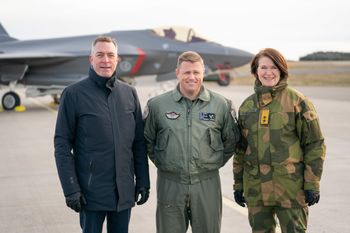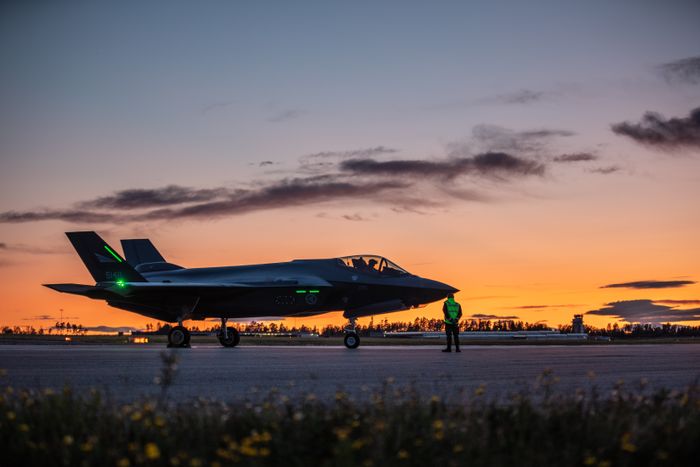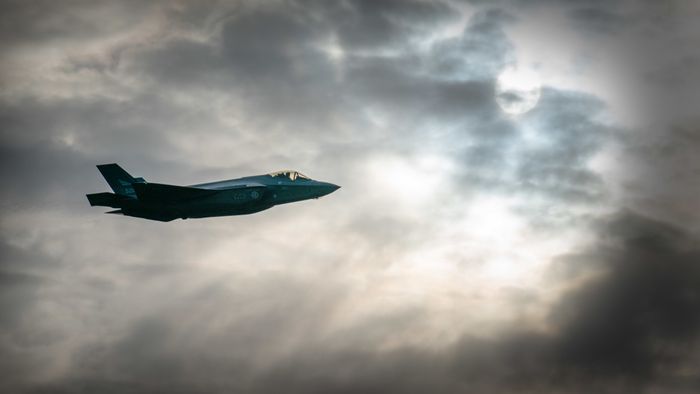A significant part of the training is getting the Norwegian F-35 pilots in the eight new simulators in Ørland - a technology that is as well-guarded as the aircraft itself.
But training in a simulator is not just about reducing the risk of loss of life and expensive material. Some of the motivation is to be able to practice the most extreme operations without also risking revealing graded information. It is important to save on powder in peace time.
It emerged in a status report that Colonel Lieutenant Ståle "Steel" Nymoen, commander of 332 Squadron, presented at Rygge Wednesday in connection with the Air Force
declaring First Operational Capability (IOC) with its 15 F-35A.
- In the F-16 era, simulator training was rarely something to look forward to, while today the pilots come out of the simulator with a wide smile. We can fly rougher in the simulator than in reality, otherwise we may get hurt showing "someone" what kind of capacity we actually have, the squadron commander said.
The road to the IOC
The
eight highly advanced simulators are used on average for two trips per day. An
estimated 30-40 percent of the training takes place virtually.

Minister of Defense Frank Bakke-Jensen, Lieutenant Colonel Ståle Nymoen, commander 332 Squadron and Major General Tonje Skinnarland, commander of the Air Force, under the IOC mark on Wednesday. Photo: Eirik Helland Urke
While F-16 pilots can only get basic training in simulator, F-35 pilots can
rely on advanced scenarios. In the simulators, the pilots get a lot of training and can test out what will be very difficult to train in reality, such as the fight against many opponents in the air. Here the limits can be pushed free of any errors.
The video at the top shows some glimpses from two years of testing and evaluation that have led to the IOC. For example, mounting a GBU-31 bomb in the abdomen, sharp shooting with Amraam air-to-air missile and finally so-called deployment to Rygge now in October and November. This is referred to as the last exam that had to be passed before Major General Tonje Skinnarland, commander of the Air Force, was able to report the aircraft ready for the Chief of Defense.
This means that the F-35A is ready to be deployed on sharp contingency missions or in international operations. Norway is the eighth nation or arms branch to declare IOC ("initial operational capability").
Anyone who has followed with at least half an eye knows that there have been some issues that have had to be resolved along the way in the F-35 program. Which is neither unusual for such large technology development programs in general, nor fighter jets in particular. For the Air Defense, the last has been a brake screen that is
not as reliable as it should have been and needs to be redesigned. Without Nymoen being willing to see the big problem.
- I'm not afraid to use the brake chute. Remember that we have had the F-35 for two years and should have them for another 40. Challenges will certainly emerge in the future as well, but they are being addressed, Nymoen said.

F-35A fighter aircraft landed for the first time at Rygge Air Station on September 17, 2019. The final exam before the IOC was nine days of deployment in October and November. Photo: Onar Digernes Aase / Armed Forces
Better performance, lower price at the right time
Compared to, for example, the NH90 helicopters, the Norwegian F-35 acquisition becomes the success story of the times. Defense Minister Frank Bakke-Jensen, who participated in the IOC marking, recalled that in fact, as early as 2011, the goal was for the Norwegian aircraft to achieve the first operational capability in 2019. That they achieved.
- With the F-35 in place, we have a plane that far exceeds what the F-16 has ever delivered. This is much more than an F-16 replacement, but a weapon system that supplies the entire Armed Forces with a number of new capabilities we have never had before. The fighter jets are delivered on time, with better performance than expected and with a lower unit price than planned, the defense minister said in his speech on the airstrip where the first F-16 aircraft landed on January 15, 1980.
The F-16 aircraft now have two years left in the Norwegian defense. All of them are gathered in 331 squadron in Bodø where they will continue to deliver QRA readiness for NATO ("Quick Reaction Alert") out 2021. From 2022 this job is taken over by F-35 from Evenes.
In terms of unit price, which describes aircraft and engine without additional equipment, it stood at $114 million for the first two aircraft Norway received in the fall of 2015. The six aircraft that Norway received in 2018 cost $ 96.6 million and were realized according to the Ministry of Defense. about one and a half million dollars lower than planned.
The recent agreement between Lockheed Martin and the JPO multinational program office prices F-35A in the upcoming production lot 12 to $82.4 million, down to $79.2 million in lot 13 and $77.9 million in production lot 14. Thus, they have come under $80 million one lot earlier than planned. This is the price of US aircraft for the USAF, while the
Norwegian ones cost about one and a half million dollars more, mainly because of the brake chute.

F-35A over Rygge. Photo: Eirik Helland Urke
F-35A returns from deployment
The Norwegian planes' first scheduled deployment now, as they are operational, is to Iceland in March, where they will exercise air control on behalf of NATO.
The US Air Force was the first to deploy the F-35A in combat. Last week, they returned home to Hill Air Base, just north of Salt Lake City, Utah, after
six months at the Al-Dhafra base in the United Arab Emirates. According to the USAF, the planes have been used, among other things, for close support and general deterrence in the region.
- We demonstrated to our allies and enemies that the F-35A is ready for any mission it is assigned, says Colonel Lieutenant Joshua Arki, commander of the 4th Fighter Squadron.






 Mielenkiintoisen näköinen.
Mielenkiintoisen näköinen.

